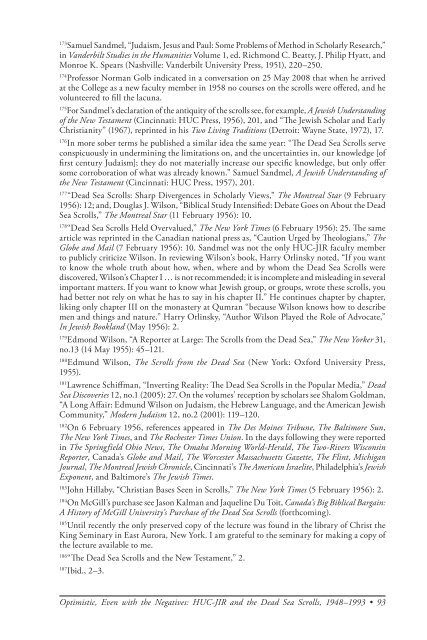The American Jewish Archives Journal, Volume LXI 2009, Number 1
The American Jewish Archives Journal, Volume LXI 2009, Number 1
The American Jewish Archives Journal, Volume LXI 2009, Number 1
You also want an ePaper? Increase the reach of your titles
YUMPU automatically turns print PDFs into web optimized ePapers that Google loves.
173Samuel Sandmel, “Judaism, Jesus and Paul: Some Problems of Method in Scholarly Research,”<br />
in Vanderbilt Studies in the Humanities <strong>Volume</strong> 1, ed. Richmond C. Beatty, J. Philip Hyatt, and<br />
Monroe K. Spears (Nashville: Vanderbilt University Press, 1951), 220–250.<br />
174Professor Norman Golb indicated in a conversation on 25 May 2008 that when he arrived<br />
at the College as a new faculty member in 1958 no courses on the scrolls were offered, and he<br />
volunteered to fill the lacuna.<br />
175For Sandmel’s declaration of the antiquity of the scrolls see, for example, A <strong>Jewish</strong> Understanding<br />
of the New Testament (Cincinnati: HUC Press, 1956), 201, and “<strong>The</strong> <strong>Jewish</strong> Scholar and Early<br />
Christianity” (1967), reprinted in his Two Living Traditions (Detroit: Wayne State, 1972), 17.<br />
176In more sober terms he published a similar idea the same year: “<strong>The</strong> Dead Sea Scrolls serve<br />
conspicuously in undermining the limitations on, and the uncertainties in, our knowledge [of<br />
first century Judaism]; they do not materially increase our specific knowledge, but only offer<br />
some corroboration of what was already known.” Samuel Sandmel, A <strong>Jewish</strong> Understanding of<br />
the New Testament (Cincinnati: HUC Press, 1957), 201.<br />
177 “Dead Sea Scrolls: Sharp Divergences in Scholarly Views,” <strong>The</strong> Montreal Star (9 February<br />
1956): 12; and, Douglas J. Wilson, “Biblical Study Intensified: Debate Goes on About the Dead<br />
Sea Scrolls,” <strong>The</strong> Montreal Star (11 February 1956): 10.<br />
178 “Dead Sea Scrolls Held Overvalued,” <strong>The</strong> New York Times (6 February 1956): 25. <strong>The</strong> same<br />
article was reprinted in the Canadian national press as, “Caution Urged by <strong>The</strong>ologians,” <strong>The</strong><br />
Globe and Mail (7 February 1956): 10. Sandmel was not the only HUC-JIR faculty member<br />
to publicly criticize Wilson. In reviewing Wilson’s book, Harry Orlinsky noted, “If you want<br />
to know the whole truth about how, when, where and by whom the Dead Sea Scrolls were<br />
discovered, Wilson’s Chapter I … is not recommended; it is incomplete and misleading in several<br />
important matters. If you want to know what <strong>Jewish</strong> group, or groups, wrote these scrolls, you<br />
had better not rely on what he has to say in his chapter II.” He continues chapter by chapter,<br />
liking only chapter III on the monastery at Qumran “because Wilson knows how to describe<br />
men and things and nature.” Harry Orlinsky, “Author Wilson Played the Role of Advocate,”<br />
In <strong>Jewish</strong> Bookland (May 1956): 2.<br />
179Edmond Wilson, “A Reporter at Large: <strong>The</strong> Scrolls from the Dead Sea,” <strong>The</strong> New Yorker 31,<br />
no.13 (14 May 1955): 45–121.<br />
180Edmund Wilson, <strong>The</strong> Scrolls from the Dead Sea (New York: Oxford University Press,<br />
1955).<br />
181Lawrence Schiffman, “Inverting Reality: <strong>The</strong> Dead Sea Scrolls in the Popular Media,” Dead<br />
Sea Discoveries 12, no.1 (2005): 27. On the volumes’ reception by scholars see Shalom Goldman,<br />
“A Long Affair: Edmund Wilson on Judaism, the Hebrew Language, and the <strong>American</strong> <strong>Jewish</strong><br />
Community,” Modern Judaism 12, no.2 (2001): 119–120.<br />
182On 6 February 1956, references appeared in <strong>The</strong> Des Moines Tribune, <strong>The</strong> Baltimore Sun,<br />
<strong>The</strong> New York Times, and <strong>The</strong> Rochester Times Union. In the days following they were reported<br />
in <strong>The</strong> Springfield Ohio News, <strong>The</strong> Omaha Morning World-Herald, <strong>The</strong> Two-Rivers Wisconsin<br />
Reporter, Canada’s Globe and Mail, <strong>The</strong> Worcester Massachusetts Gazette, <strong>The</strong> Flint, Michigan<br />
<strong>Journal</strong>, <strong>The</strong> Montreal <strong>Jewish</strong> Chronicle, Cincinnati’s <strong>The</strong> <strong>American</strong> Israelite, Philadelphia’s <strong>Jewish</strong><br />
Exponent, and Baltimore’s <strong>The</strong> <strong>Jewish</strong> Times.<br />
183John Hillaby, “Christian Bases Seen in Scrolls,” <strong>The</strong> New York Times (5 February 1956): 2.<br />
184On McGill’s purchase see Jason Kalman and Jaqueline Du Toit, Canada’s Big Biblical Bargain:<br />
A History of McGill University’s Purchase of the Dead Sea Scrolls (forthcoming).<br />
185Until recently the only preserved copy of the lecture was found in the library of Christ the<br />
King Seminary in East Aurora, New York. I am grateful to the seminary for making a copy of<br />
the lecture available to me.<br />
186 “<strong>The</strong> Dead Sea Scrolls and the New Testament,” 2.<br />
187 Ibid., 2–3.<br />
Optimistic, Even with the Negatives: HUC-JIR and the Dead Sea Scrolls, 1948–1993 • 93

















